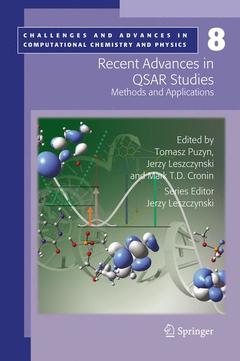Recent Advances in QSAR Studies, 2010 Methods and Applications Challenges and Advances in Computational Chemistry and Physics Series, Vol. 8
Coordonnateurs : Puzyn Tomasz, Leszczynski Jerzy, Cronin Mark T.

An interdisciplinary overview on recent advances in Quantitative Structure–Activity Relationships (QSAR) studies
Presents both a review of new ideas about methodology and new areas of QSAR applications
A simply written, practical guide for academics, industrial scientists and decision makers taking their first steps in QSAR analysis
Date de parution : 03-2012
Ouvrage de 414 p.
15.5x23.5 cm
Disponible chez l'éditeur (délai d'approvisionnement : 15 jours).
Prix indicatif 210,99 €
Ajouter au panierDate de parution : 12-2009
Ouvrage de 414 p.
15.5x23.5 cm



